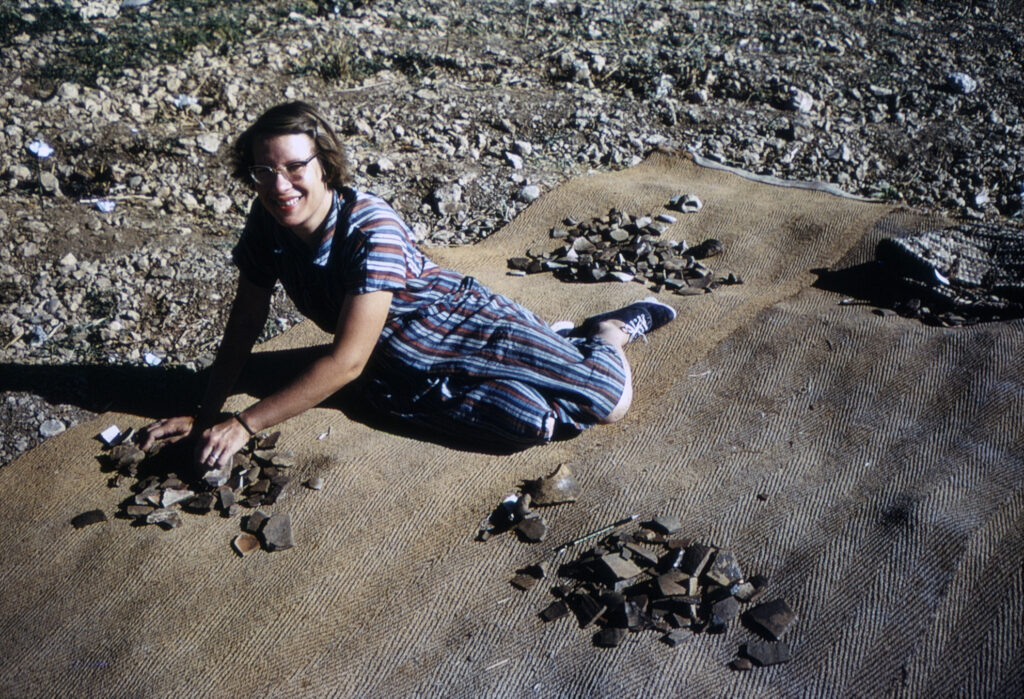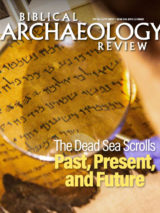Milestones: Nancy Lapp (1930–2025)
Pioneering biblical archaeologist

Nancy Lapp sorting pottery at Iraq al-Amir, Jordan, in 1962. Paul and Nancy Lapp Collection, 1962. Courtesy ACOR, Amman.
On March 3, 2025, we lost an understated and under-recognized giant in the field of biblical archaeology. Nancy Lapp (née Renn) was steadfast in her dedication to her family, to her scholarship, and to making the world a better place through her social justice efforts. Born in 1930, Nancy made significant contributions to Near Eastern and biblical archaeology throughout her career, which spanned over six decades. While she identified as a biblical archaeologist, Nancy was quick to clarify that her work was not intended to prove the Bible’s literal truth. Instead, she sought to understand the cultural and historical contexts of biblical narratives. Her approach pioneered a more nuanced perspective on how archaeology can inform biblical studies and inspired many colleagues and students.
Nancy was trained in ceramic typology during her early career, a foundational skill in archaeological analysis. Her academic journey led her to become the first female research assistant to William F. Albright at Johns Hopkins University from 1955 to 1957. Her expertise contributed to the accurate dating and interpretation of artifacts, essential for reconstructing historical contexts in biblical archaeology. After marrying Paul Lapp in 1957, together they emerged as a formidable team in biblical archaeology, participating in numerous excavations in Jordan and Palestine, including the Drew-McCormick Archaeological Expedition to Shechem
(Tell Balata). While Paul served as director of the American School of Oriental Research (ASOR) in Jerusalem (1960–1965) (now the W.F. Albright Institute of Archaeological Research), Nancy played a crucial role in managing the institute and assisting with excavations at Bâb adh-Dhrâ’, Tell Ta’anach, Wadi Daliyah, and Dhahr Mirzbanah, all while raising their five children.
Following Paul’s tragic death in 1970, Nancy dedicated her time and expertise to publishing the results of their excavations. Her sustained ethical commitment to publishing final reports from multiple excavations ensured that valuable archaeological legacy data was made available to the academic community, expanding the field’s knowledge base. She authored and co-authored several monographs and dozens of book chapters and journal articles focusing on various aspects of Near Eastern archaeology. Her expansive scholarly oeuvre encompasses analyses for many of the region’s most important Bronze and Iron Age sites, including Bâb adh-Dhrâ’, Iraq al-Amir, Tell er-Rumeith, and Tell Ta’anach, and includes enormous contributions to archaeological research methods and approaches while advancing the field of biblical archaeology.

Nancy Lapp working with younger scholars at the Kelso Museum of Near Eastern Archaeology at the Pittsburgh Theological Seminary (left to right: Megan Nishida, Tucker Deady, Nancy Lapp, Madeleine Kohl, Morag Kersel, Natalia Handziuk, and Meredith Chesson). Image courtesy of the Expedition to the Dead Sea Plain project.
In addition to her archaeological scholarship, in 1970 she became the curator of the Pittsburgh Theological Seminary’s Museum of Near Eastern Archaeology (now the Kelso Museum of Near Eastern Archaeology) and was named Curator Emerita in 2000. In this role, she transformed the museum’s exhibits, curatorial procedures, and mission, preserving and showcasing artifacts from biblical lands, contributing to public education, and encouraging early career scholars in academic research.
Nancy’s contributions to the field extend beyond excavations, museum work, and publications. Nancy and Paul Lapp’s extensive photographic collection documenting their expeditions has become an invaluable resource for researchers. Donated to the American Center of Research (ACOR) in Jordan, this archive preserves visual records of archaeological sites and artifacts, supporting ongoing studies in the region. She also served as a trustee emerita at ACOR.
Nancy was a true storyteller; her enthusiasm and passion for archaeology helped to captivate and educate the public about biblical archaeology. Her dedication to this work and her efforts to preserve and publish important research made an indelible mark on the field of Near Eastern archaeology. Through her various contributions, she advanced the field and fostered a deeper understanding of the historical and cultural context of the Bible. Her work enriched the methodologies and ethical standards of biblical archaeology, leaving a lasting legacy in the field and inspiring new generations of archaeologists.
Morag Kersel is Associate Professor of Anthropology at DePaul University. She is co-director of the Follow the Pots Project and the Expedition to the Dead Sea Plain.
Meredith Chesson is Professor of Anthropology at the University of Notre Dame. She is co-director of the Expedition to the Dead Sea Plain and the Follow the Pots Project.
Become a BAS All-Access Member Now!
Read Biblical Archaeology Review online, explore 50 years of BAR, watch videos, attend talks, and more

Must-Read Free eBooks
Want more Bible history?
Sign up to receive our email newsletter and never miss an update.
Unlock Unlimited Access to the Bible's Past
Become an All-Access Member to explore the Bible's rich history. Get Biblical Archaeology Review in print, full online access, and FREE online talks. Plus, enjoy special Travel/Study discounts. Don't miss out—begin your journey today!












